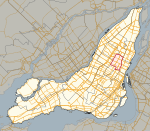Saint-Esprit-de-Rosemont Church
20th-century Roman Catholic church buildings in CanadaArt Deco architecture in CanadaMontreal stubsRoman Catholic churches completed in 1933Roman Catholic churches in Montreal ... and 1 more
Rosemont–La Petite-Patrie

The Church of the Holy Spirit of Rosemont (French: Église St. Esprit de Rosemont) (formerly the Church of Ste. Philomène), is a Roman Catholic church in the Rosemont–La Petite-Patrie borough of Montreal, Quebec, Canada. Built between 1931 and 1933, it is one of the rare churches with Art-deco architecture. The architect Joseph-Égilde-Césaire Daoust, completed the foundations and basement, 1922–23; and completed the church, 1932-33.It is situated on Masson Street, in the heart of the Vieux-Rosemont neighbourhood.
Excerpt from the Wikipedia article Saint-Esprit-de-Rosemont Church (License: CC BY-SA 3.0, Authors, Images).Saint-Esprit-de-Rosemont Church
Rue Masson, Montreal Rosemont–La Petite-Patrie
Geographical coordinates (GPS) Address Nearby Places Show on map
Geographical coordinates (GPS)
| Latitude | Longitude |
|---|---|
| N 45.547777777778 ° | E -73.575277777778 ° |
Address
Rue Masson 2851
H1Y 1X1 Montreal, Rosemont–La Petite-Patrie
Quebec, Canada
Open on Google Maps






